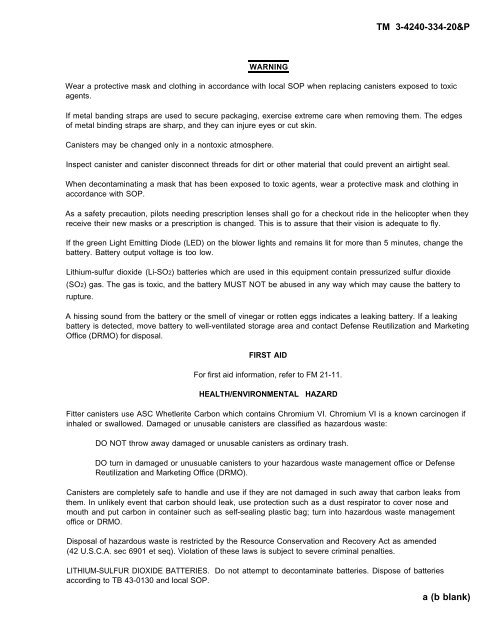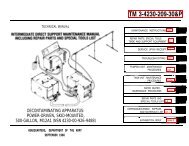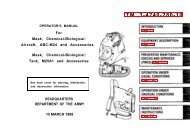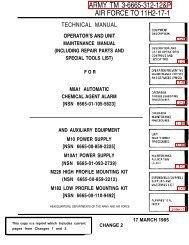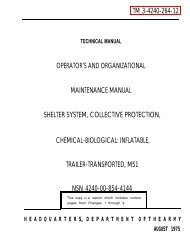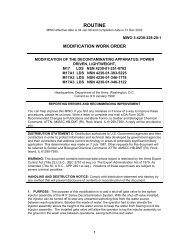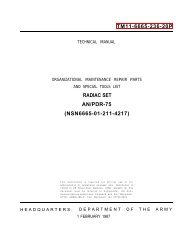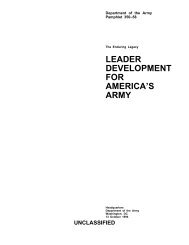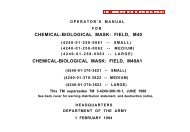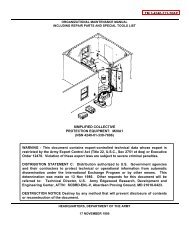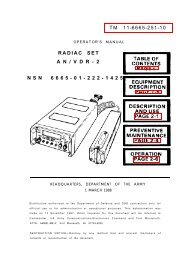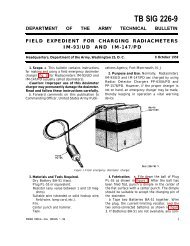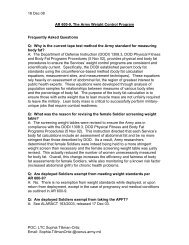TM 3-4240-334-20&P
TM 3-4240-334-20&P
TM 3-4240-334-20&P
Create successful ePaper yourself
Turn your PDF publications into a flip-book with our unique Google optimized e-Paper software.
<strong>TM</strong> 3-<strong>4240</strong>-<strong>334</strong>-20&P<br />
WARNING<br />
Wear a protective mask and clothing in accordance with local SOP when replacing canisters exposed to toxic<br />
agents.<br />
If metal banding straps are used to secure packaging, exercise extreme care when removing them. The edges<br />
of metal binding straps are sharp, and they can injure eyes or cut skin.<br />
Canisters may be changed only in a nontoxic atmosphere.<br />
Inspect canister and canister disconnect threads for dirt or other material that could prevent an airtight seal.<br />
When decontaminating a mask that has been exposed to toxic agents, wear a protective mask and clothing in<br />
accordance with SOP.<br />
As a safety precaution, pilots needing prescription lenses shall go for a checkout ride in the helicopter when they<br />
receive their new masks or a prescription is changed. This is to assure that their vision is adequate to fly.<br />
If the green Light Emitting Diode (LED) on the blower lights and remains lit for more than 5 minutes, change the<br />
battery. Battery output voltage is too low.<br />
Lithium-sulfur dioxide (Li-SO2) batteries which are used in this equipment contain pressurized sulfur dioxide<br />
(SO2) gas. The gas is toxic, and the battery MUST NOT be abused in any way which may cause the battery to<br />
rupture.<br />
A hissing sound from the battery or the smell of vinegar or rotten eggs indicates a leaking battery. If a leaking<br />
battery is detected, move battery to well-ventilated storage area and contact Defense Reutilization and Marketing<br />
Office (DRMO) for disposal.<br />
FIRST AID<br />
For first aid information, refer to FM 21-11.<br />
HEALTH/ENVIRONMENTAL HAZARD<br />
Fitter canisters use ASC Whetlerite Carbon which contains Chromium VI. Chromium VI is a known carcinogen if<br />
inhaled or swallowed. Damaged or unusable canisters are classified as hazardous waste:<br />
DO NOT throw away damaged or unusable canisters as ordinary trash.<br />
DO turn in damaged or unusuable canisters to your hazardous waste management office or Defense<br />
Reutilization and Marketing Office (DRMO).<br />
Canisters are completely safe to handle and use if they are not damaged in such away that carbon leaks from<br />
them. In unlikely event that carbon should leak, use protection such as a dust respirator to cover nose and<br />
mouth and put carbon in container such as self-sealing plastic bag; turn into hazardous waste management<br />
office or DRMO.<br />
Disposal of hazardous waste is restricted by the Resource Conservation and Recovery Act as amended<br />
(42 U.S.C.A. sec 6901 et seq). Violation of these laws is subject to severe criminal penalties.<br />
LITHIUM-SULFUR DIOXIDE BATTERIES.<br />
according to TB 43-0130 and local SOP.<br />
Do not attempt to decontaminate batteries. Dispose of batteries<br />
a (b blank)


